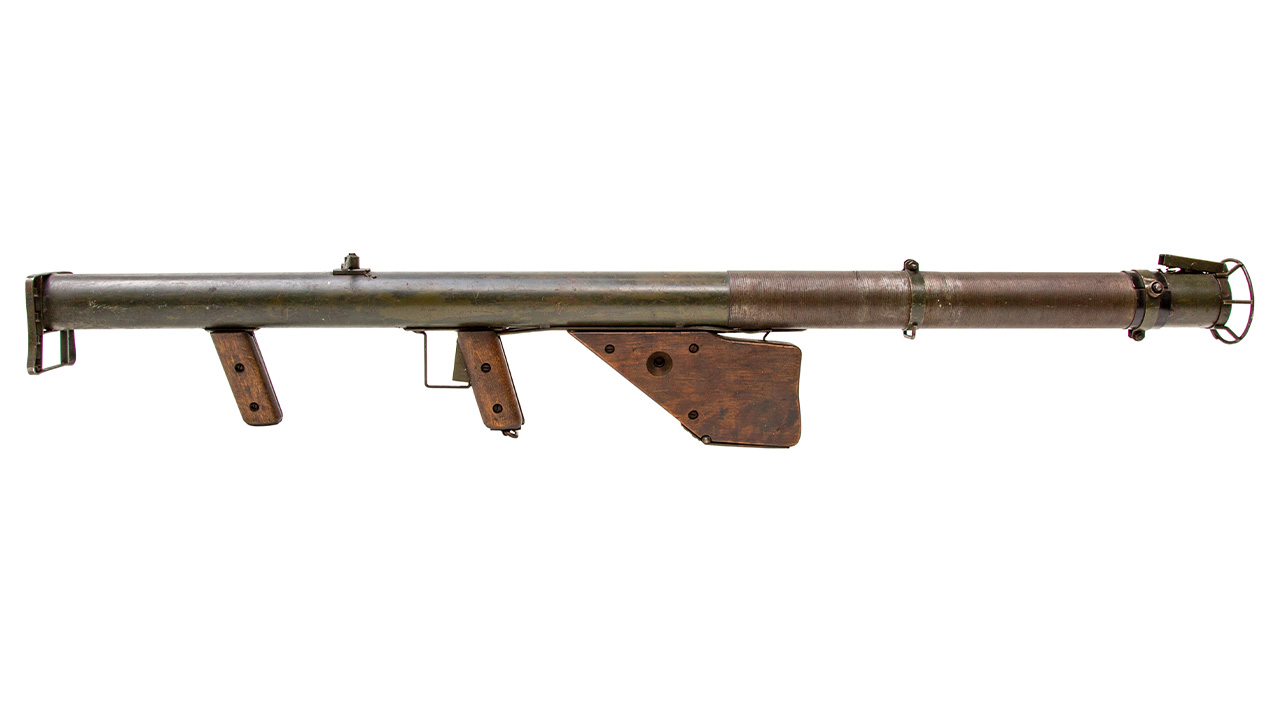The fundamental issue with the armament of the insurgent 1st Czechoslovak Army in Slovakia was the lack of effective anti-tank weapons, both heavy weapons and infantry weapons. In addition to tanks and anti-tank guns, the insurgent army had only Soviet PTRD-41 and PTRS-41 anti-tank rifles delivered in a total of 256 pieces via an air bridge. Despite their general popularity among insurgents, the weapons’ features were no longer sufficient for all the German armoured vehicles deployed in the Uprising. Much more effective weapons – bazookas – were supplied to the insurgents by the USA by planes. Despite their effectiveness, even using these weapons in the Uprising brought difficulties.
After the end of the war, individual pieces of anti-tank weapons from the Uprising were found in Slovakia. For example, in the village of Dubové (Martin County), citizens handed over, among other infantry weapons, one “anti-tank rocket launcher”. Similarly, one of the insurgent weapons fell into the hands of the National Security Corps members and subsequently into the collections of the Museum of the Slovak National Uprising. Since 1958, the Museum of the SNU has almost continuously exhibited an insurgent Bazooka serial number 2824 marked “Stanley Made in USA” in its permanent exhibition.
The experience of anti-tank warfare on the fronts of the Second World War showed the need to introduce more effective small anti-tank weaponry into the arsenal of militaries rather than the previously used anti-tank rifles. This issue was addressed by all the great powers except the Soviet Union. Thus, the U.S. Army gradually introduced the M1 Bazooka Rocket Launcher (M1 R.L., and its subsequent versions). Bazooka was in production in 1942; its official name was the M1 Rocket Launcher, but the soldiers named it after the distinctive musical instrument Bazooka of the famous American comedian Bob Burns. It was fired using an electric battery stored in the shoulder rest. The effective range was about 100 meters; the weapon could penetrate about 80 mm of armour at this distance. Bazooka was handled by two men, a gunner, and a loader. By the end of the war, Bazooka had undergone several modifications to improve its combat characteristics and to simplify production.
Bazooka weapons fell into the hands of Slovak soldiers during the Slovak National Uprising. The first 12 pieces of the M1 R.L. Bazooka were delivered by the USA to the Tri Duby airfield on 17 September 1944. In a second delivery on 7 October 1944, 150 Bazookas were brought in. Training for the new weapons took place mainly in Banská Bystrica and its surroundings, or directly within the units where the weapons were assigned. The training was conducted by American instructors at first and later by trained Slovak soldiers. The weapons were allocated to individual insurgent infantry battalions or other army units such as the Armoured Battalion, the Army Engineer Battalion, or the 2nd Czechoslovak Parachute Brigade. Part of the Bazookas were also given to partisan brigades. A specialised unit equipped with Bazookas was the Anti-Tank Company “Urban”. The training proved mostly short and insufficient; moreover, batteries were missing, the number of rockets supplied was insufficient, and the insurgent soldiers did not quite master the weapon.
Insurgent soldiers achieved several successful hits on German armoured vehicles with this weapon. One worth mentioning was the destruction of a tank, probably a Pz.Kpfw. 38(t), by the units of the Korück 531 rear area command, which was destroyed on 19 October 1944 by the members of the 11th Infantry Battalion in the area of Telgárt. Another two vehicles, a Sd. Kfz. 251 transporter and a StuG III self-propelled gun, were lost by the 18th SS-Panzer Grenadier Division Horst Wessel in the area of Brezno, Podbrezová. These two successes were accomplished by the so-called separate bazooka teams.
Overall, about two-thirds of the Bazookas delivered were used by the insurgents in combat operations and training. The rest was stored in warehouses at the end of October 1944 and ended up in the meadows of Donovaly, where they were seized by German troops. The use of the M1 Rocket Launcher Bazooka in the Uprising is still relatively unknown to the general public, but the heroism of the insurgent soldiers in combat against German armoured vehicles deserves our attention and respect.
PhDr. Marian Uhrin, PhD.
